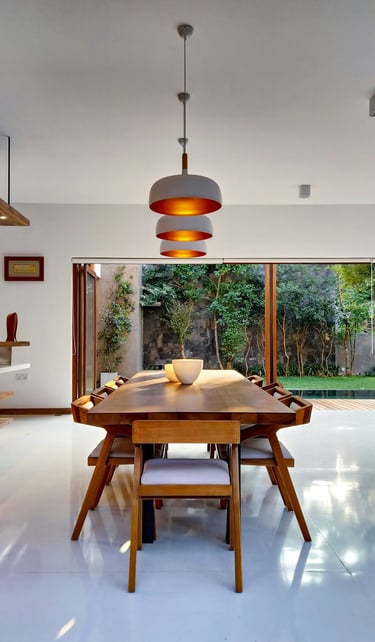How to Blend Interior Styles Seamlessly
Learn how to mix modern, vintage, and bohemian styles effortlessly. Discover elegant tips for creating a cohesive, curated home design.
1/25/20254 min read
Mixing interior design styles is one of the most exciting ways to create a home that feels uniquely you. A little modern minimalism here, a touch of rustic charm there - when balanced correctly, the result is a beautifully layered space that feels curated, not chaotic.
At Moodspiration, we believe that blending interior styles is an art form - one that tells your story through contrast, texture, and personality. Whether you’re combining modern and vintage, bohemian and Scandinavian, or industrial and coastal, this guide will help you achieve a cohesive, harmonious look that feels intentional and inspired.
1. Start with a Defined Vision
Before diving into decor shopping or rearranging furniture, start with clarity. The biggest mistake people make when mixing styles is skipping this step.
Ask yourself:
What mood do I want this space to evoke?
Which styles truly reflect my personality?
Which pieces do I already own that I want to highlight?
Once you’ve identified your dominant style (for example, mid-century modern), you can layer in complementary elements - like boho textures or coastal tones - to create depth and contrast.
Pro Tip: Create a mood board on Pinterest with keywords like “modern boho living room” or “industrial Scandinavian bedroom.” Visualizing your aesthetic helps you refine your color palette and materials before making any decisions.
2. Choose a Unifying Color Palette
A cohesive color palette is the secret to making different styles feel connected.
If your furniture and decor vary widely in design, a consistent palette will tie everything together visually. Start with two or three base colors that set the tone - think soft neutrals like white, beige, or charcoal - and layer in accent shades that reflect your secondary style.
For example:
Modern + Boho: mix crisp white walls with warm terracotta, mustard, and natural wood.
Scandinavian + Vintage: pair cool greys with muted greens and aged brass accents.
Industrial + Coastal: combine deep navy and black metal with light oak and linen textures.
Keeping your color scheme consistent across furniture, textiles, and artwork ensures harmony - even when styles vary.
3. Balance Proportions and Shapes
When combining design styles, balance is everything. Mixing too many bold shapes or ornate pieces can quickly overwhelm a space.
Contrast structured, clean-lined furniture (like a mid-century sofa) with softer, organic elements (like a jute rug or rattan chair). Or pair the industrial edge of metal shelving with the warmth of vintage ceramics.
This balance of hard and soft, modern and classic creates visual rhythm - the key to a seamless blend.
Pro Tip: If one style is naturally bolder (say, industrial), use it as an accent rather than the foundation. Let the subtler style (like minimalist Scandinavian) anchor the space to prevent visual chaos.
4. Layer Textures and Materials
When blending different styles, textures are your best friend. They add depth, warmth, and cohesion - especially when styles feel contrasting.
Combine materials like:
Wood and metal (industrial meets rustic)
Linen and velvet (modern meets vintage)
Marble and rattan (classic meets coastal)
Use repeating textures to create consistency - for example, if you introduce black iron in your lighting, echo that finish in cabinet hardware or decor accents.
A room rich in tactile contrast feels inviting, layered, and lived-in - not showroom-perfect.
5. Mix Eras Thoughtfully
Blending old and new elements gives your home character, but intentionality is key.
Anchor the space with timeless, modern furniture pieces and layer in vintage finds that tell a story. An antique mirror above a sleek console, or a distressed wooden coffee table beside a minimalist sofa, strikes the perfect note between nostalgia and now.
Pro Tip: Keep vintage pieces in good proportion. One or two standout antiques per room are usually enough to make a statement without overwhelming the modern foundation.
6. Use Repetition to Create Flow
Even the most eclectic interiors need repetition to feel cohesive. Repeat key elements - colors, shapes, or finishes - across multiple rooms to create a sense of unity.
If you use brass lighting in your living room, echo that metal in your kitchen hardware. If curved furniture defines your bedroom, carry that shape into your wall art or decor in the hallway.
This repetition builds visual continuity, making your design feel intentional and elevated rather than accidental.
7. Style with Personality
The most beautiful interiors aren’t perfectly styled - they feel personal.
Once your foundation is balanced, bring in decor that reflects who you are: travel souvenirs, family heirlooms, handmade pottery, or books that inspire you. These details soften the edges between styles and add the warmth of authenticity.
After all, a truly well-designed home doesn’t follow trends - it tells your story.
8. Know When to Edit
Mixing styles can be liberating, but restraint is what keeps it sophisticated. Step back and evaluate your space:
Does every piece contribute to the overall vision?
Is there enough breathing room between design statements?
Do the colors and materials feel balanced?
Editing is what separates a thoughtfully layered home from a cluttered one. Let your most beautiful pieces shine by giving them space to breathe.
Final Thoughts
Blending interior styles seamlessly is less about following rules and more about curating balance. When color, texture, and form work together, you can combine nearly any aesthetic - from modern to vintage, boho to minimalist - into a home that feels cohesive, comfortable, and uniquely yours.
Embrace contrast. Trust your instincts. And remember: the best interiors evolve with time, just like your personal style.
You May Also Like
Want daily inspiration? Follow Moodspiration on Pinterest for curated interior styles and home décor finds that match your taste.


